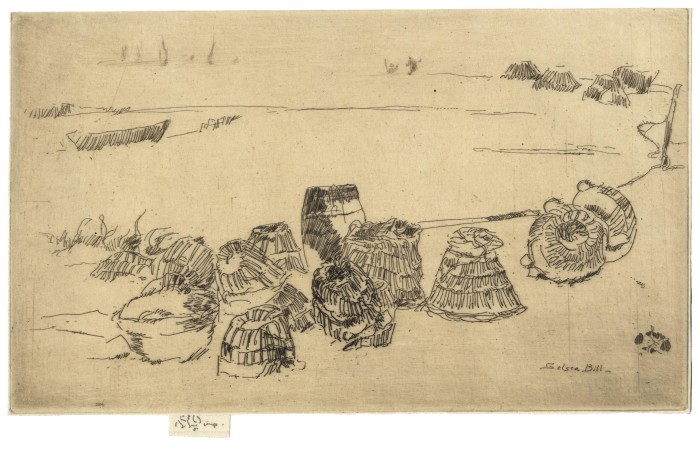Lobster Pots – Selsea Bill
James Whistler (1834-1903), Lobster Pots – Selsea Bill, etching and drypoint, 1880-1, signed with the butterfly on the tab and inscribed “imp.” [also signed with the butterfly in the plate, and titled Selsea Bill, lower right]. Reference: Kennedy 235, Glasgow 241, fourth state (of 4). From the Twenty-Six Etchings (the Second Venice Set). In excellent condition, printed on a laid paper with a partial Strasbourg Lily watermark. 4 3/4 x 8 inches.
Provenance:
Bernard Buchanan MacGeorge (his stamp verso, Lugt 394
Henry Harper Benedict (his stamp verso, Lugt 1298)
Charles C. Cunningham (his stamp verso, Lugt 4684)
A very fine impression, printed in a brown ink with plate tone over all; wiped selectively so that the foreground is a shade darker.
The plate was first exhibited at The Fine Art Society in London in 1883. In 1886 it was published as part of A Set of Twenty-Six Etchings, the so-called “Second Venice Set,” by Messrs. Dowdeswell and Thibaudeau.
The etched inscription at lower right locates the scene in Selsea Bill, a small town on the south coast of England where Whistler was visiting Charles Augustus Howell. There is a wistfulness in this slight composition, suggesting that the print was made right after Whistler’s return from his first trip to Venice. However, as Robert Getscher aptly remarks, “even the Venetian subjects are never this inconsequential”. To our modern eyes, however, this makes the print all the more intriguing. Lobster-Pots is one of Whistler’s freest linear exercises: clusters of parallel stripes countered by aureoles of radiant hatching. Walter Sickert would soon afterwards move similarly close to pure abstraction in some of his beach-related etchings like Scheveningen, Bathing Machines of 1887 (Bromberg 95) and, especially, the small Scheveningen, Wind-Chairs and Shadows of the same year (Bromberg 91).
